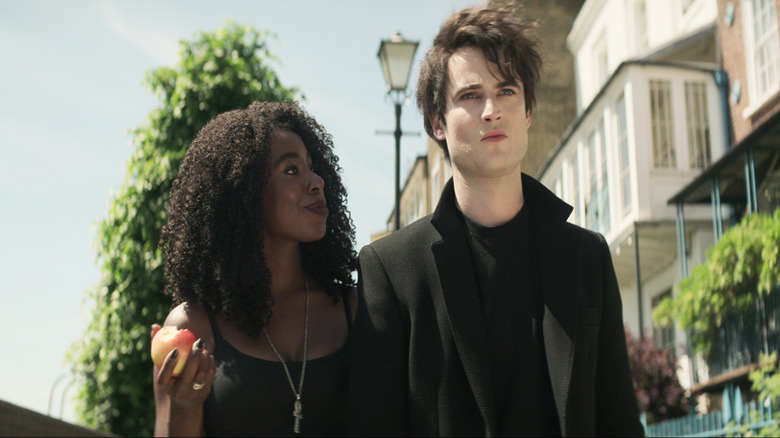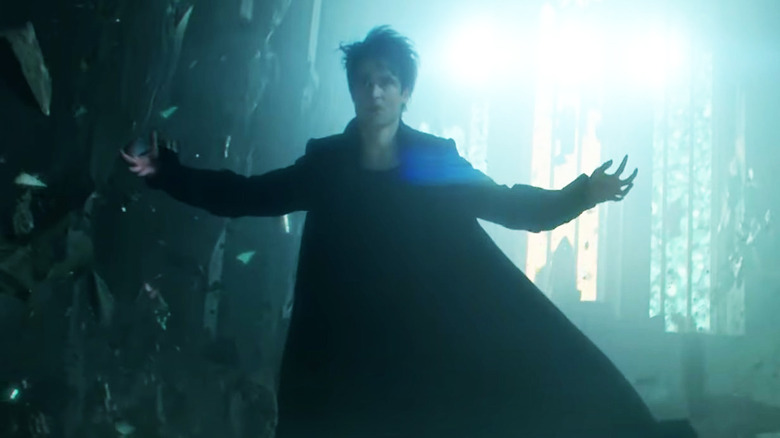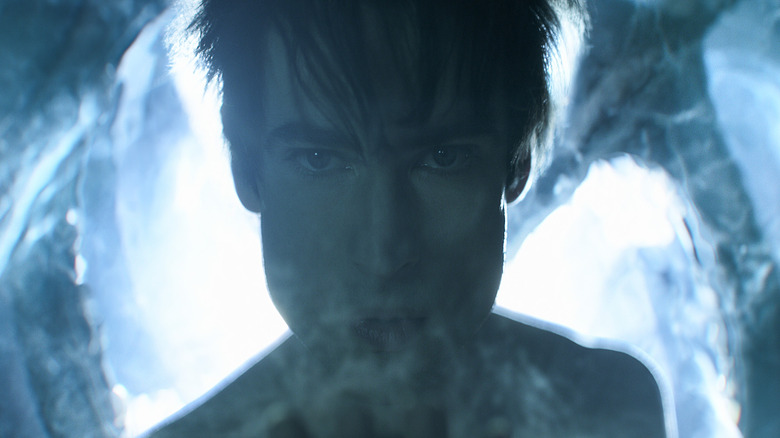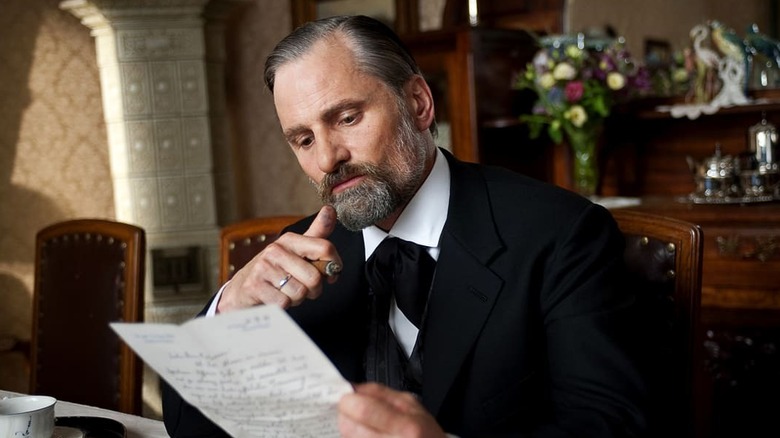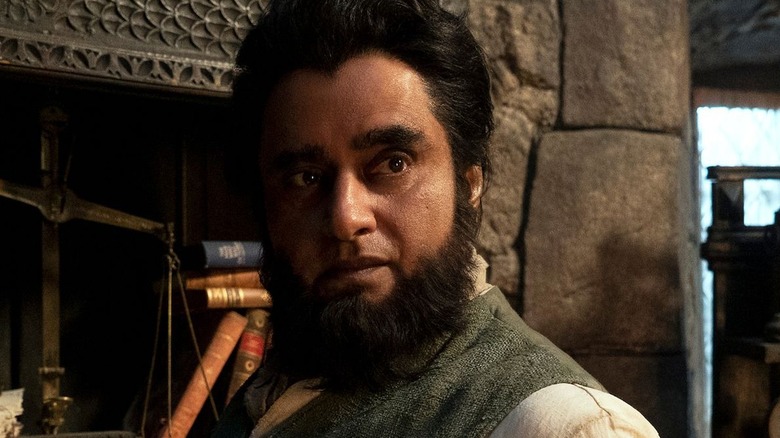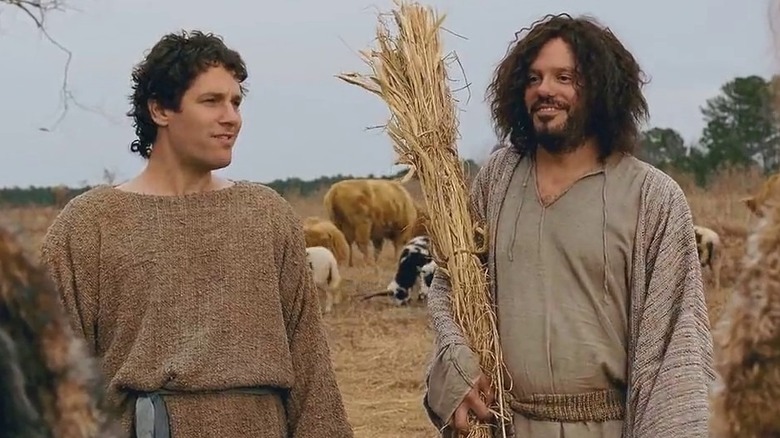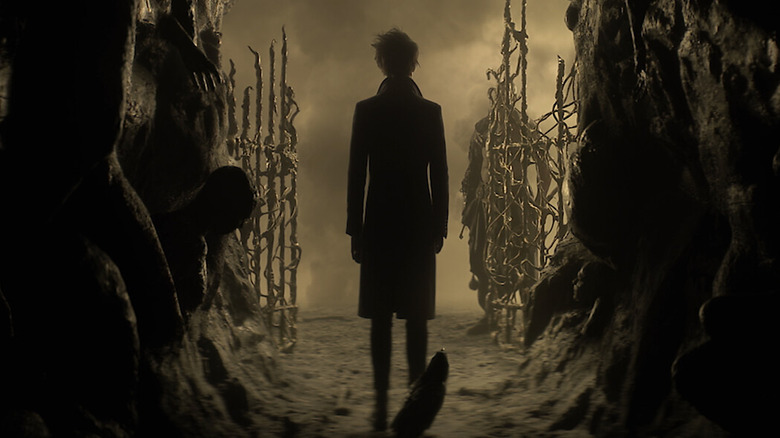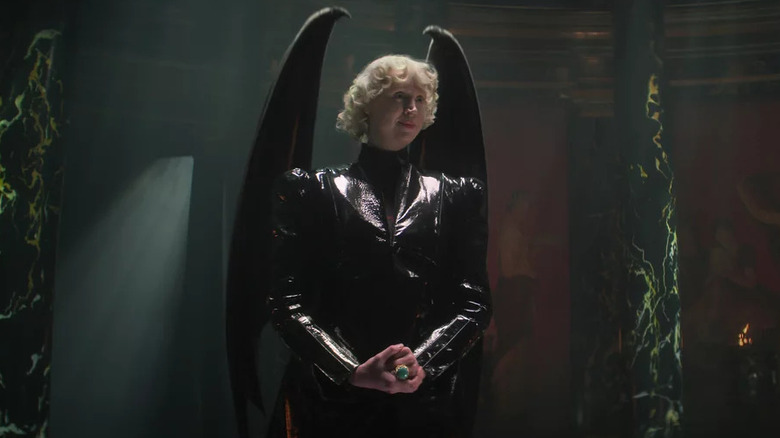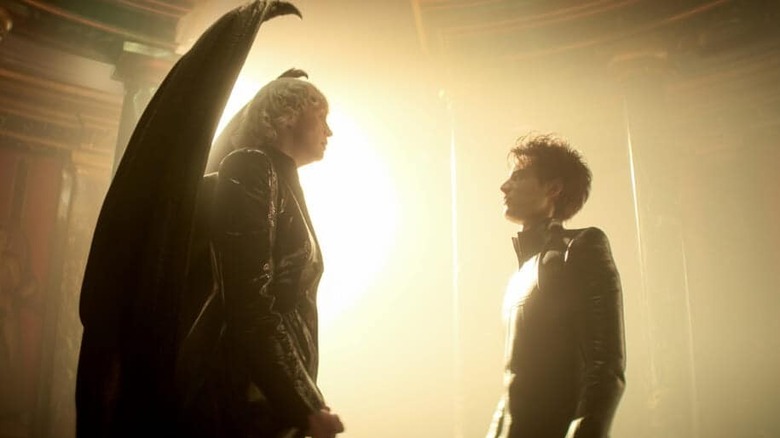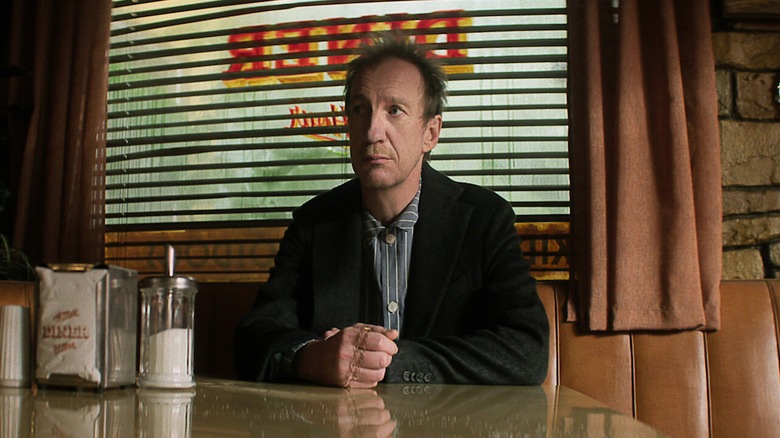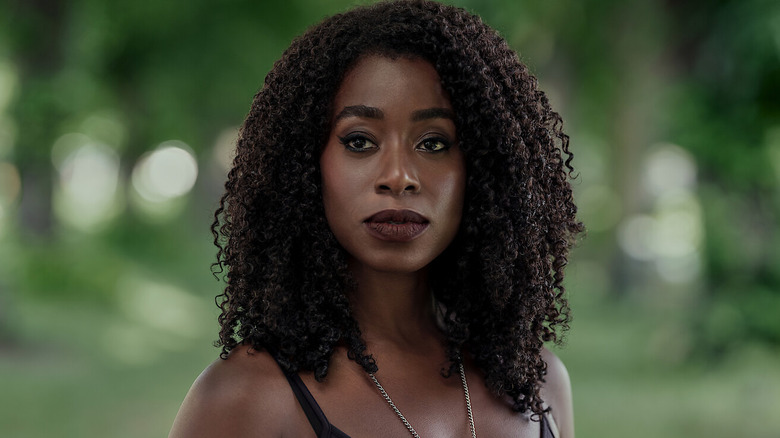Sandman Moments That Make Us Question Everything
In 2022, the veil between waking life and dreams is razor-thin. A 2021 survey found that three out of five Americans felt more exhausted than ever. With many still working from home in the ongoing COVID-19 pandemic, bedrooms are nebulous spaces that house sleep and service alike. Pop entertainment responded accordingly. Disney +'s "Moon Knight" concerned a hero who couldn't tell the difference between his awoken and slumberous states. The fourth season of "Stranger Things," a smash that yielded that 2022 song of summer, featured a villain who invaded people's minds and made their nightmares reality. Now comes Netflix's "The Sandman," the long-awaited adaptation of Neil Gaiman's seminal horror comic about Morpheus, the king of dreams, and those who would strip his power from him.
That's a lot to digest, even when the source material comes from an author who is known for heady yet accessible fantasy. In truth, "The Sandman" is arguably Gaiman's most metaphysically challenging effort ever. Every installment of the show (and source material) pierces the veil between conscious and subconscious, dream and reality. "The Sandman" invites audiences not only to question reality as they know it but accept that the world is a lie and that the path to greater emotional intelligence and a fuller human existence means interrogating and embracing dreams. Appropriately, "The Sandman," is chock-full of moments that make its audience question everything; here are 10 of them.
When the show first enters The Kingdom of Dreams
The sweeping, establishing shot of a fantastical land is a cliché as old as cinema itself. Think "The Wizard of Oz," or more recently, "The Lord of The Rings" or "Black Panther." Given that "The Sandman" is a fantasy-horror epic, it's only fitting that it would reveal Morpheus' Kingdom of Dreams in spectacular fashion. The way it does so, though, asks audiences to question their and humanity's entire evaluation system of what matters in existence. Neil Gaiman, Allan Heinberg, and David S. Goyer waste no time taking audiences to the dream and raising these quandaries as the first look occurs less than a minute into the first episode, "Sleep of the Just."
"We begin in the waking world, which humanity insists on calling the real world," Morpheus intones as a carriage-bound carrier named Dr. John Hathaway (Bill Paterson) begins to doze off. "[You mortals act] as if your dreams have no effect upon the choices you make," Morpheus continues, "[You] go about your work, your loves, your wars as if your waking lives were all that mattered ... But there is another life that awaits you when you close your eyes." Viewers then see Hathaway in the Dreaming, surrounded by fantastical creatures. Hathaway appears aware and conscious of these creatures and the kingdom, which begs the question: does that mean humans have separate existences in the dream realm? And, if yes, is the audience of "The Sandman" primarily aware of their lesser existence?
The Dream Kingdom
Within its first minute and change, "The Sandman" has audiences asking if their interpretations of love, war, and vocation are the primary currency for moving through life. If they aren't, is the realm people often half-remember, that of dreams, as vital to their waking existence as being awake itself? The show then drops a tantalizing hint about its point of view by posing these questions just as it flexes its impressive visual prowess.
The Kingdom of Dreams is, to put it mildly, awe-inspiring. The raven sweeps through a gloomy, rain-flecked cemetery past an attacking gargoyle named Gregory before instantly passing into a blue-skied land of architectural riches. Giant hands hold a bridge joining the palace and town. Dr. Peterson, now on the bridge, watches a ship captained by a mythical beast head towards the palace where nightmarish creatures (a dragon and a pumpkin-headed man) live side by side with ethereal ones (like a unicorn).
The suggestion here, however slight, is that the Kingdom of Dreams is built on a hierarchy where the subconscious is handed gifts or mental albatrosses by the higher power that is Morpheus. As he states near the end of this sweeping extended shot, "Dreams and nightmares [are] what I create, and which I must control, lest they destroy you." The idea that one entity is responsible for the current of impulses and confrontations with fear that run beneath our social norms undoes all of modern psychology.
The power of making the unconscious conscious
Sigmund Freud, often considered the father of modern psychology, hoped that humans could make their unconscious conscious. The Freudian theory supposes unconscious impulses govern more of people's daily lives than they realize (hence, Freudian slips) and Carl Jung, another noted philosopher, added to this dialogue. He theorized that dreams were the psyche's endeavor to communicate the unconscious to an individual. So, modern psychology is unquestionably in a healthy dialogue with the nature of dreaming.
Both of those ideas, however, are rooted in the notion that humans create their own dreams. Dreams stem from them, and their own waking life begets them. In "The Sandman," it is a single individual and his kingdom who watch over the unconscious impulses of an entire race. What's more, humans' ignorance towards this kingdom keeps them, as a species, unevolved and not so blissfully unaware. The collective faith of an entire society is inherently misplaced. That in and of itself is head-spinning, but the way "The Sandman" serves up modern philosophy as a kind of cultural MacGuffin truly makes audiences want to question everything.
When Cain murders Abel over their pet gargoyle Gregory
This one's a lot to unpack. Early on in the second episode of "The Sandman," "Imperfect Hosts," Dream (Tom Sturridge) needs to retrieve some of his sand to have access to his powers again. There is nothing left in the kingdom that can provide it. There is only someone. Gregory, the pet gargoyle of Cain and Abel, is constructed from Dream's sand. If Dream unmakes him, his power will return. On the massive downside, though, Gregory will be no more.
Credit where credit is due: The unmaking of Gregory is one of the most triumphant and tear-jerking moments in "The Sandman," a minor marvel of CGI and economic storytelling. It also buries a lede that makes audiences' heads spin. Gregory belongs to Cain and Abel, who are residents of the dream world. Cain and Abel, more famously, are also characters in the Bible.
If two prominent religious characters are part of Morpheus' dream kingdom, does that mean everyone else from that book is as well? That's a question with massive implications, to put it mildly. Even more fascinatingly, the death of Gregory is punctuated by Abel stabbing Cain, seemingly not for the first time. Does this mean Cain and Abel are stuck in a storytelling loop and victims of a strain of narrative predestination? The implications of that are staggering.
The power of repeated stories
Recall part of Morpheus' voice-over narration from the first episode: "[You] go about your work, your loves, your wars as if your waking lives were all that mattered." One implication of this excerpt is that what occurs in the dream world carries as much if not more value than what happens in waking existence. If this is the case, "The Sandman" is slyly acknowledging that the stories of the Bible (and, by extension, other religious tomes) are important. One could argue that the show's trip to Hell in Episode 4, "A Hope in Hell," explicitly makes that point. It doesn't.
"Imperfect Hosts" cements this idea by having Cain and Abel live through the beat of their story audiences are most familiar with. If it is occurring in the dream world, then its setup, action, and resolution still matter in daily human existence. The average "Sandman" viewer is familiar with the story. That familiarity hasn't dulled the story's necessity. Some stories need to be told again and again because audiences still gain the power to grow, change, or be moved by them. "The Sandman" understands this and asks audiences to question which ones they hold dear by weaving Cain and Abel into its kaleidoscopic fabric.
When Hell makes its residents provide their own fire
Hell, traditionally, is a dominion in which those who have sinned in life are meant to burn for eternity. This is innately understood by anyone who consumes pop culture. Look to Netflix's recent season of "Stranger Things" for proof, where much of Season 4 hinges on a manhunt for Eddie Munson (Joseph Quinn), who runs a Dungeons and Dragons cabal called The Hellfire Club. When Chrissie (Grace Van Dien) is killed by Vecna (Jamie Cambell Bower) in Eddie's trailer, Eddie's association with "hellfire" fuels the mounting suspicion around him. Hell is hot the way water is wet; if it weren't, there would be cause for concern. Enter Episode 4 of "The Sandman."
When Morpheus (Tom Sturridge) and Matthew the Raven (a sublime Patton Oswalt) enter Hell in a fetch quest to retrieve Morpheus' helm, Matthew is quick to take a breath that catches in his chest. When he exhales, cold air is visible. Matthew is as shocked as the audience and the surprises only mount from there. Morpheus and Matthew witness a procession of sinners in the distance, who have or have not provided their own flames to stay warm.
If anyone watching "The Sandman" wasn't questioning the nature of Hell before this visual, they certainly are after. Hell, in "The Sandman," is a realm where suffering is as psychological as it is physical. Hell's residents' inability to self-care furthers their damnation. Their eternity is an everlasting reminder of the personal ability they lack, even in the afterlife. Hell is often imagined as the pain inflicted on the body. In "The Sandman," Hell turns your heart to ash.
When hope springs eternal because of Hell
That's only the beginning of how Hell makes audiences question everything in "The Sandman." To retrieve his precious helm from the demon who stole it, Morpheus must battle Lucifer (Gwendoline Christie of "Game of Thrones" fame) in combat. If "The Sandman" viewers are anticipating a physically taxing fight with expansive action choreography, that's understandable. "The Sandman" is based on a Vertigo comic book, and action set pieces are the parlance of modern, mainstream comic book films and television series.
"The Sandman" isn't a traditional comic book. Here, Morpheus and Lucifer transform into a series of objects using only their words and, in doing so, inflict damage on each other. It's a moment that seemed impossible to film on the page but works beautifully here. More importantly, its conclusion is brain-warping and makes audiences interrogate the nature of Hell even more than they already are.
The power of hope
Near the end of their face-off, Lucifer has Morpheus dead to rights. He is shivering on the ground, a victim of Lucifer's non-stop psychological onslaught. Matthew the Raven is convinced Morpheus can counter one last time and attempts to rouse him into a final, battle-winning effort. Matthew's optimism has the desired effect, yet its manifestation through Morpheus is still surprising enough to make audiences question what they hold dear.
To beat Lucifer in combat, Morpheus transforms himself into hope. Hope, Morpheus argues, is the one thing that is truly eternal in any realm. Hope is un-killable. Hope has survived the fall of kingdoms and civilizations and holocausts and more horrors than are fit to print here or speak aloud. On one level, audiences understand this whether or not they believe in it. What is challenging, in the best sense, is the notion that hope exists beyond the human body.
Hope is not a feeling people manifested and named. Hope is, like the Greek Daemon (and, later, the Roman word "genius"), something that moves through humans, that they are possessed by in the most wonderful way. To feel hope is to tap the divine and access a power that transcends everyday waking existence. That's more power than audiences usually give hope and a radical reframe of what it actually means to be hopeful. It's one of the most radical notions "The Sandman" offers, even more so because of the episode that follows.
Truth eradicates hope in 24 Hours
"24 Hours" is "The Sandman" at its most bleak and emotionally devastating, a nearly stand-alone offering that throws a handful of upstate New York residents into a diner and subjects them to the machinations of John Dee (David Thewlis). Dee experiments upon the diner patrons with a ruby stolen from Morpheus and, by and large, that experimentation makes them all explicitly honest. Their brash honesty takes the form of food orders, admissions of attraction, actual intercourse, and, eventually, murder and self-mutilation. It's pitch-black stuff.
On its surface, this doesn't sound so different than many a potboiler or stark and spare horror film. The elements of "24 Hours" which makes audiences question everything are only in sharp relief when held in concert with "A Hope in Hell." Simply put: the truths John Dee extracts from everyone in the diner briefly make them hopeless. The truth sets them free, but freedom means staring into the proverbial void.
There is a litany of cultural suggestion which implies humans will feel better after telling the truth. Honesty is hard but cleansing. The reality is that honesty, like most feelings, needs the benefit of time to reach its final form and impact upon a person. Honesty can (and possibly should) make a person feel hopeless. It might not be forever, but it could. The rekindling of hope is a powerful possibility but not a certainty. The machinations of "24 Hours" make audiences question the cost of their honesty and how gentle to be on themselves in the wake of revelation. Both are wonderful paths of inquiry.
When Death is kind and life-loving
Death has been depicted and anthropomorphized in more ways than most can count throughout pop culture. There's the chess-playing version played by Bengt Ekerot in Ingmar Bergman's legendary "The Seventh Seal." Brad Pitt played a different but equally gravitas-laden (and, later, memeable) version of Death in "Meet Joe Black." In almost every realization of Death as a person, the common threads are dignity and ponderance. Death is burdened by their job and subliminally seems to embody humanity's fear of meeting its maker. They are also almost always a man. That, thrillingly and mind-blowingly, is not how Death (an exceptional Kirby Howell-Baptise) is portrayed in "The Sandman."
When fans first see Death, she's radiating humanity and giving Morpheus (Tom Sturridge) a pep talk. Her insights are tough but rich in kindness and affection for her sibling. "Did it never occur to you that I would be worried about you?" Death chides. Moments later, she's buying and relishing apples from a street vendor. Death is technically the opposite of life, but "The Sandman" invites audiences to question death itself by making Death someone who adores the world of the living.
Death isn't death; ending humans' lives is Death's job. People are rarely only defined by their profession, but "The Sandman" extends this idea to the realm of the ephemeral. That's a decision that makes audiences question Death itself and their relationship to it.
